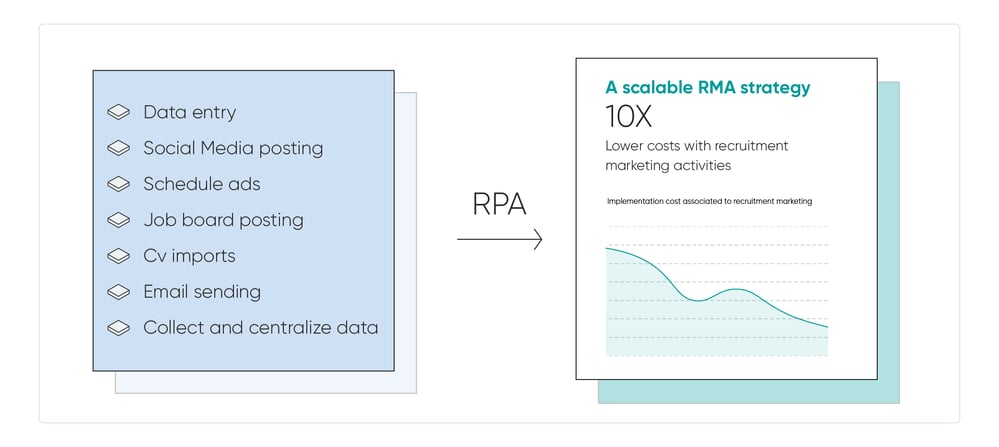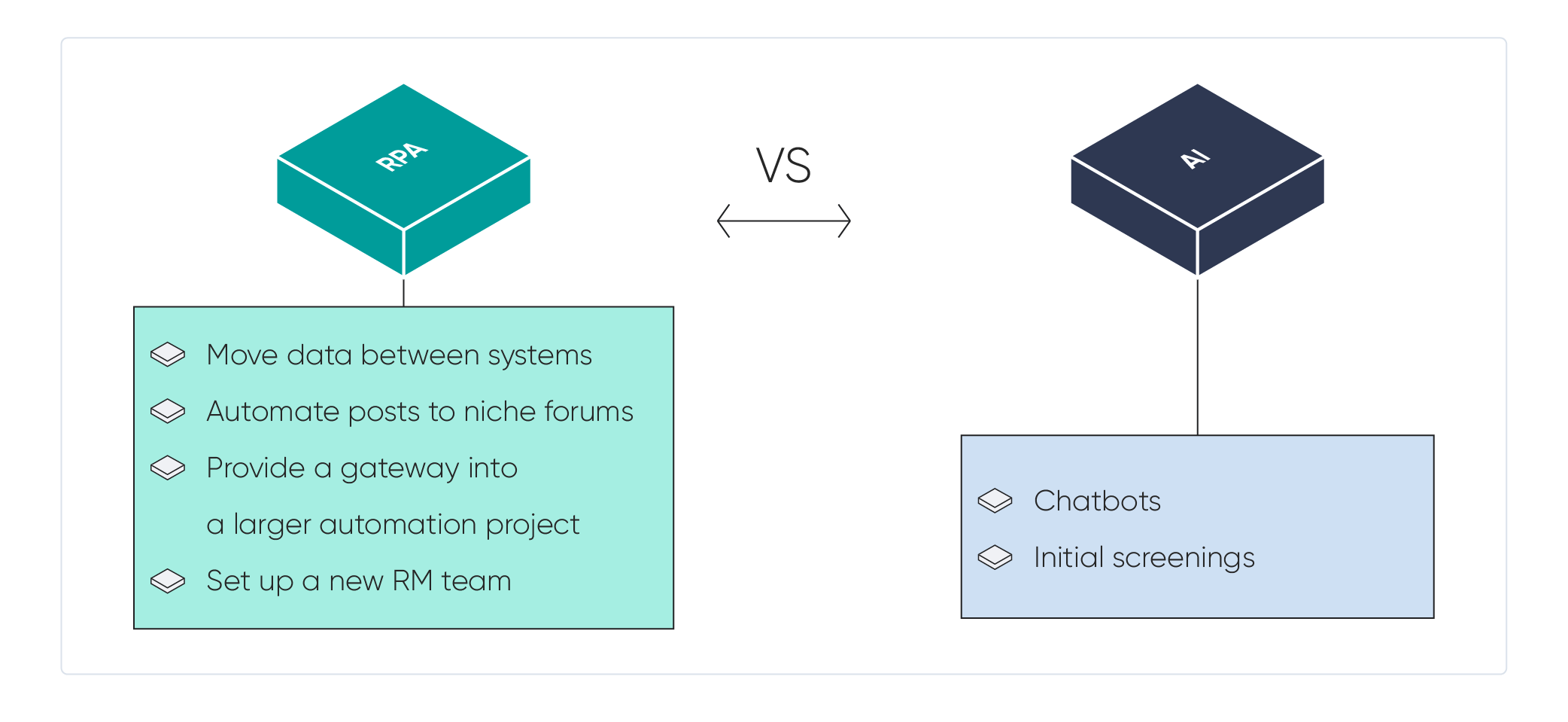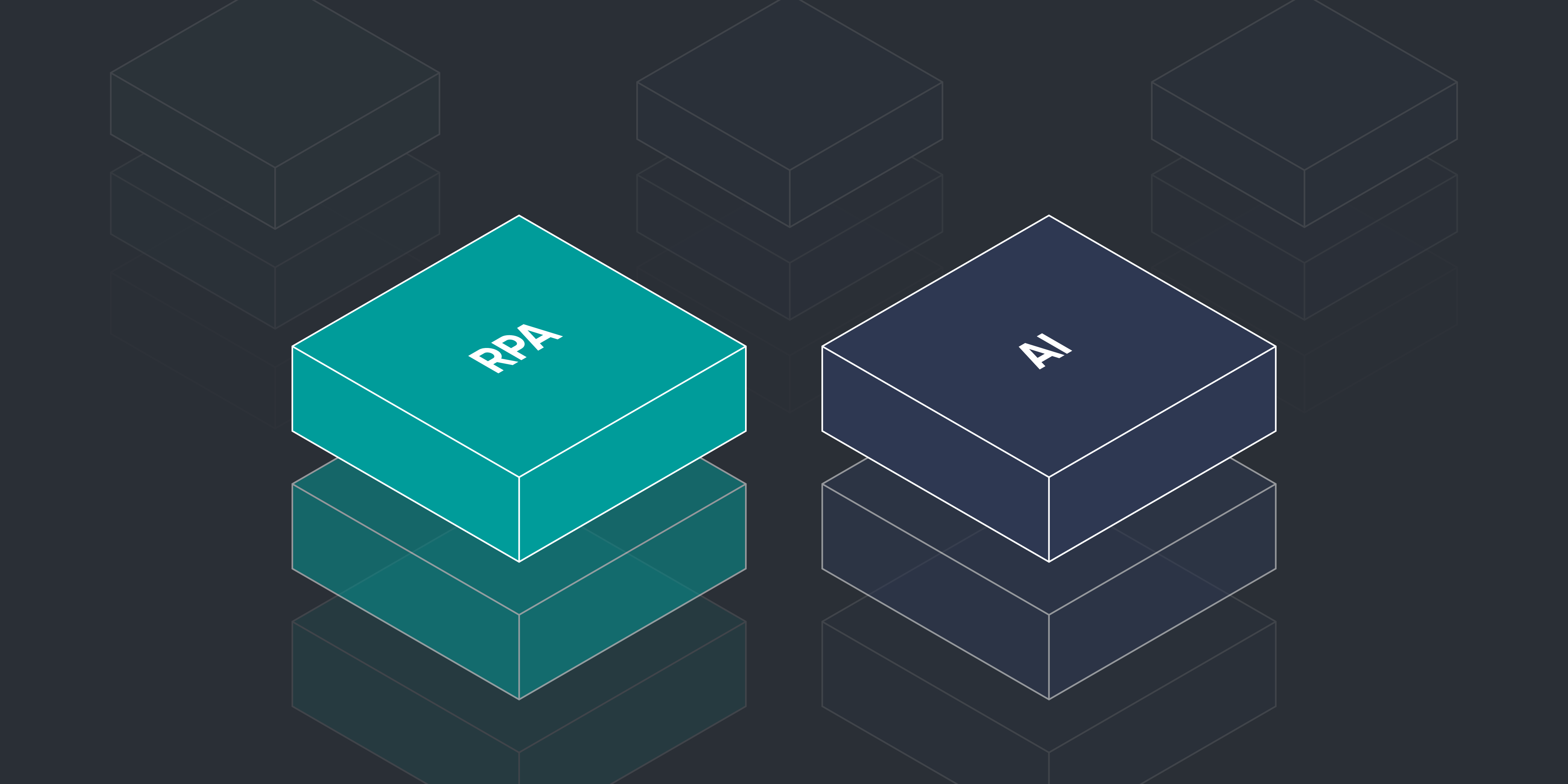Why did you get into recruiting?
We’re going to hazard a guess and say it wasn’t because you love inputting potential candidate information into spreadsheets for hours on end. Oh, then moving that data around between your CMS and CRM systems, and if you’re really lucky, into a legacy ATS that doesn’t even allow bulk imports.
If that’s how you’re spending your days, read on for a rundown of some of the emerging technology designed to give you a hand with that data entry and manipulation, so you can get back to the human-centric aspects of recruiting, you know, the actual reason you get started in this field.
AI vs. RPA, What are They and What Can They Do for You?
Before we get too far into the weeds, let’s lay out what we’re talking about and be sure we’re all on the same page with working definitions. We’re going to run down the differences between two technologies, artificial intelligence (AI) and robotic process automation (RPA). We’ve seen a lot of misleading advice out there on the internet that seems to be fueling a misunderstanding of just what these are and how they differ, yet complement each other.
AI: Artificial intelligence is a discipline within computer science that focuses on creating computers that can think like humans. This an overarching category, meaning that AI either is or soon will be a part of multiple computer-based business solutions.
RPA: Robotic process automation is one of those business solutions. The term is used to describe a collection of emerging technologies that aim to automate, via software-based robots called “bots,” the rote and repetitive data manipulation tasks that take up so much of your time. These bots can only do the tasks they are specifically programmed, or configured, to do. They’re essentially “dumb” in that respect. Although some solution providers are beginning to include AI in their RPA packages that will enable on-the-job learning.
Cool, So What Does All That Mean for RM?

Both of these technologies are poised to have huge impacts on the HR world. And RM will probably see the most disruption, being the newest and fastest-growing segment of the industry.
By enabling you to automate the time-consuming tasks of data entry and manipulation, RPA will free up dozens of hours per week so your team can get back to the high-value tasks of coaching candidates, interacting with stakeholders face-to-face, crafting the perfect job description, and spreading your EB far and wide via social media.
Of course, you’re already using a recruitment marketing automation solution to automate your social media updates and blog posts, right?
Additionally, AI-powered chatbots stand ready to free up even more of your team’s time by handling front-line Q&A duties. The chatbots can be pre-programmed with standard FAQs and instructions for when to pass the inquiry over to your human team, but the real power will become obvious several months after deployment. That’s when the AI will have had time to learn answers to even more questions you didn’t even think to include in the original script.
And because we’re talking about computers, all calculations and data involved are guaranteed to be accurate.
OK, Sold. Now, How Do We Put These Technologies to use for our Team?
We’ve already mentioned some of the uses for both AI and RPA, so let’s look at a couple of them in a bit more detail, shall we?

RPA can be used to:
- Move data between systems: It can even move data from a spreadsheet into a modern CRM platform, or from a legacy system that lacks an API into a modern system. This is because RPA bots use the same user interface that your human workforce is currently using to accomplish these tasks, mouse clicks and copy/paste included.
- Automate posts to niche forums: Not all social media sites have APIs for RMA tools to use. That doesn’t mean you’re stuck posting manually as RPA can pick up the slack by posting to these sites on whatever schedule you configure.
- Set up a new RM team: With a low cost of entry and fast set up times, RPA is a great way to get a small RM team up and functioning quick. Great for startups working on a shoestring budget.
- Provide a gateway into a larger automation project: Many organizations are seeing RPA as just the first step toward a greater degree of automation in the workplace. Because it works across legacy and current systems alike, RPA is a fantastic way for a smaller company to dip a toe in the automation waters before deciding on the big ones like AI or RMA.
And AI excels in:
- Chatbots: These tools will allow your potential candidates to have their questions answered anytime, 24/7.
They can be directed to further resources on your website, have their chat transferred to a human agent (during office hours, of course), or even begin the application process right from the chat interface.
Ultimately, these chatbots can walk a candidate from one end of their candidate journey to the other, helping guide decision-making by analyzing their answers to questions, determining cultural fit, and more.
- Initial screenings: Rather than making your human team scan 100s or 1,000s of applications and resumes, have your AI agent do it.
In many companies, rudimentary AI is already doing the first round of scanning. However, recent developments in machine learning mean that these AI agents can be programmed for semantic search terms. That means they’ll be able to parse everyday speech to assist in determining how well a candidate will fit into the office, as well as actually conducting the first voice or video interview.
When it comes to these two technologies and their uses in recruitment and talent acquisition, there’s overlap.
As discussed above, AI is finding its way into RPA solutions to facilitate bot learning. This will ultimately mean, for example, that the bots will be able to self-adjust when the UI of a piece of software is updated and a menu item moves.
In the meantime, each of these sets of technologies has a lot to offer existing RM teams and there are myriad ways you and your team can make great use of them to free up your time for the more intuitive, human-interaction-based aspects of your daily workflow.







